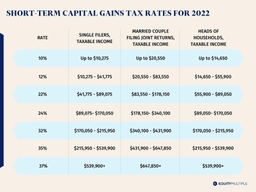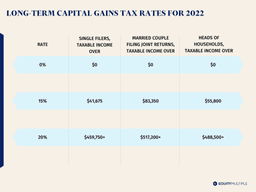Short Term Capital Gains Tax
Capital gains are the profits earned by selling capital assets, such as stocks, bonds, or real estate among others. Capital gains are taxed at a rate based on the length of time an investor held the asset before selling. Any losses from the sale of assets are known as capital losses.
Short Term vs Long Term
If an investor held an asset for less than a year before selling it, the profits are short term capital gains. If the holding period longer than one year, the profits are long term capital gains. Short and long term gains are taxed at different rates, with short term rates based on the ordinary income tax bracket of the investor. Long term gains are taxed based on income as well, but with generally more favorable rates. All EquityMultiple investments are held for longer than one year, so any profits resulting from them would be considered long term capital gains.
The 2022 short term capital gains federal tax rates are 10%, 12%, 22%, 24%, 32%, 35%, or 37% depending on income and filing status. See the chart below for more information.
The long term capital gains federal tax rates for the 2022 tax year are 0%, 15%, or 20% depending on income and filing status. See the chart below for more information.
Special Considerations
The concept of capital gains is relatively simple, but there are a number of special considerations for investors calculating their tax rates. These include but are not limited to:
- Principal Residence: Investors may exclude up to $250,000 when single or up to $500,000 when filing jointly from taxation for capital gains earned on the sale of their primary residence. For a property to be classified as a “principal residence,” the investor must have owned and lived in the home for at least two of the five years preceding the sale. It is typically not possible to exclude multiple home sales from capital gains taxes within two years.
- State tax: A number of states collect taxes on capital gains on top of what is owed at the federal level. Laws vary by state, with some treating gains more favorably than others. Investors should be aware of the laws and regulations in their state when buying and selling capital assets.
- Collectible Assets: Capital gains earned on collectible items, such as antiques, coins, precious metals, art, and wine, are taxed at 28% regardless of income or how long they were held.
- Changing rates: The capital gains rates listed above apply to the 2022 tax year and are subject to change annually. Based on President Biden’s current proposal, rates may increase so that taxpayers with incomes over $1 million would pay a tax of 43.4% on capital gains. More on this tax plan here. When selling assets, taxpayers should stay up to date on current laws and keep an eye on proposed changes.
- Capital Losses: Capital losses may be used as tax deductions. The IRS allows investors to sum their gains and losses to determine a net capital gain or loss. In the case of net gain, this new total is the amount taxable. In the case of net loss, investors can use up to $3,000 to reduce their taxable income. If the losses exceeded $3,000, the remaining amount may be carried forward to put against future capital gains or ordinary income.
Bottom Line
Capital gains tax rates vary by holding period, regular income tax bracket, state, filing type, asset type, and year. They are an important consideration when planning an investment strategy and buying or selling capital assets.
Disclosure: EquityMultiple does not provide tax, legal or accounting advice.
This material has been prepared for informational purposes only, and is not intended to provide, and should not be relied on for, tax or accounting advice. You should consult your accounting advisor before engaging in any transaction.
For more information on capital gains tax, see these resources:

